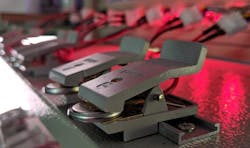Hollow Nanocrystals May Lead to Anodes for Li-ion Batteries that Don’t Degrade
A team of researchers at The Georgia Institute of Technology recently discovered that nanometer-sized antimony crystals spontaneously form hollow structures. This could be a boon for lithium batteries by letting them have higher energy densities without shorter lives. This could also stretch out the time between charges.
The flow of lithium ions in and out of lithium battery anodes has long been a limiting factor in how much energy the batteries could hold using conventional materials. If the ion flow is too high, the anode swells and then shrinks during charge-discharge cycles, degrading the material in the anode and shortening battery life.
To address that issue, Georgia Tech researchers developed hollow “yolk-shell” nanoparticles that handle the volume changes caused by ion flow. Making those particles, however, was complex and costly.
Then the team discovered that particles a thousand times smaller than the width of a human hair spontaneously form hollow structures during the charge-discharge cycle without changing size. This would let anodes made of such particles handle more ion flow without being damaged.
“Our discovery could offer an easier, low-cost and streamlined process to make the hollow structures to serve as anodes,” says Matthew McDowell, assistant professor at Georgia Tech.
The researchers made their discovery using a high-resolution electron microscope that lets them see battery reactions at the nanoscale. The team, which included researchers from ETH Zürich and Oak Ridge National Laboratory, also used modeling to create a theoretical framework for understanding why the nanoparticles spontaneously hollow rather than shrink when lithium ions are removed from the battery.
Eventually the engineers determined that antimony crystals only form and reversibly fill hollow particles during battery cycling if they are oxide-coated and less than 30 nanometers in diameter. The native oxide layer lets the tube expand when lithium ions flow in, then mechanically prevents shrinking as voids form in the antimony when the ions are removed.
Antimony is relatively expensive and not used in commercial battery electrodes. But the team believes spontaneous hollowing may also happen in less-costly related materials such as tin. Next steps would include testing other materials and mapping a pathway to commercial scale-up.
Though they may be costly, the self-hollowing antimony nanocrystals have another interesting property: They could also be used in sodium-ion and potassium-ion batteries, emerging designs for which much more research must be done.

